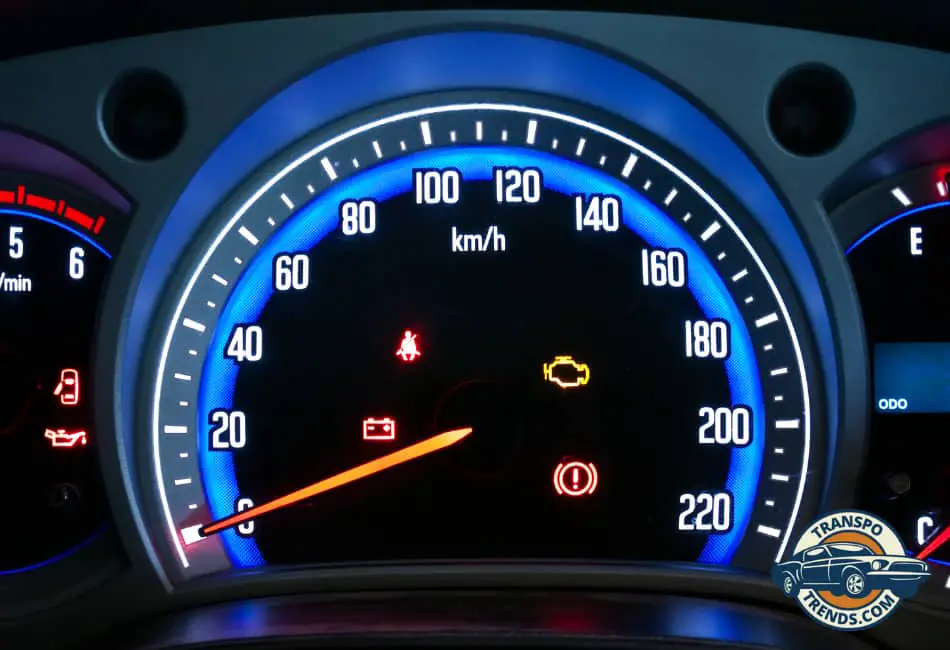Your car’s dashboard is a hub of vital information about your vehicle’s health. While most of us are familiar with the basic warnings such as the fuel gauge or the speedometer, there are several other important warning lights that demand immediate attention.
Ignoring these could lead to severe damage or potential safety hazards. In this article, we will delve into eight crucial dashboard warning lights that you should never dismiss.
Let’s ensure your vehicle is always in top-notch condition, and most importantly, that you’re driving safely.
Dashboard Lights You Shouldn’t Ignore
1. Check Engine Light
The iconic check engine light is an absolute must-pay-attention-to warning. It indicates that a system in the vehicle is malfunctioning and needs immediate inspection.
A faulty oxygen sensor, mass airflow sensor, or catalytic converter may cause the check engine light to flicker on your dashboard. If you notice this light, take it to a certified mechanic for an engine diagnostic immediately.
2. Oil Pressure Warning Light
Your oil pressure warning light indicates that the oil levels in your engine are running low or there may be a problem with the lubrication system. Low oil levels can cause irreversible damage and should not be ignored.
Check to make sure that you have enough oil in your engine by using the dipstick or referring to your car’s manual for more information. If the light continues to flicker, you must take it to a mechanics for further inspection.
3. Battery Warning Light
If your battery warning light is illuminated, it usually indicates that the charging system within the vehicle is malfunctioning.
It’s a good idea to get your battery checked and tested by a professional at a certified service station.
It may also be necessary for you to replace your battery if it has been in use for over four years.
Ignoring this warning light can lead to engine failure as the battery is responsible for supplying power to crucial parts, such as your ignition and fuel injection system.
4. Brake System Warning Light
If the brake system warning light turns on, it is indicating that there is a problem with your braking system.
It could be something as minor as low brake fluid levels, or more serious such as an issue in the brake caliper or the ABS system.
It’s best to get your car checked by a professional mechanic right away if you see this warning light to avoid any potential hazards while driving. The brakes are one of the most important safety features in a car so don’t take any chances!
5. Airbag Warning Light
The airbag warning light will turn on when there is a fault in the airbag system.
If this light comes on, you should have your car inspected by a mechanic right away to make sure that the airbags are functioning properly and able to deploy if needed.
Your car’s manual may provide additional information about how to troubleshoot an airbag issue. However, it is always best to rely on a professional for these types of repairs as they may require specialized tools and knowledge.
It’s also important to note that if your car has been in a collision recently, the airbags should be replaced regardless of whether or not the warning light is illuminated. This will ensure that the airbags are ready to protect you if needed.
6. Engine Temperature Light
The engine temperature warning light will illuminates if the engine’s temperature is too high. This can be caused by a lack of coolant, a failing water pump, or even an overheating issue.
If this light turns on, you should take immediate action to avoid further damage to your car’s engine.
Pull over in a safe location and turn off the engine. Allow it to cool for a few minutes, then check your coolant level and top up if necessary.
If the light remains illuminated after topping up the coolant, you should get your car checked by a mechanic as soon as possible.
They may need to replace faulty components or diagnose other issues that could be causing your engine temperature to rise.
It’s also a good idea to regularly check your coolant levels and top up if necessary as this can help prevent overheating related issues.
Additionally, make sure to get any other engine service needs taken care of on schedule in order to keep your car running in tip-top shape.
7. Coolant Temperature Warning Light
The coolant temperature warning light will turn on if the engine’s coolant is too hot. This can be caused by a lack of coolant, a failing water pump, or another issue.
If this light turns on, you should take immediate action to avoid further damage to your car’s engine.
Pull over in a safe location and turn off the engine. Allow it to cool for a few minutes, then check your coolant level and top up if necessary.
If the light remains illuminated after topping up the coolant, you should get your car checked by a mechanic as soon as possible.
They may need to replace faulty components or diagnose other issues that could be causing your engine temperature to rise.
8. Tire Pressure Monitoring System (TPMS) Warning Light
The Tire Pressure Monitoring System (TPMS) warning light will turn on when the pressure in one or more of your car’s tires is too low.
If you see this warning light, you should stop and check your tire pressure levels immediately.
Low tire pressure can be dangerous as it affects the traction and handling of the vehicle, making it difficult to control.
You can check your tire pressure with a simple pressure gauge and then add air if necessary.
If the warning light persists, have your tires inspected for any underlying issues such as worn tread or punctures.
It’s also important to regularly check tire pressure levels and keep them at the manufacturer’s recommended level. Doing this can improve your car’s handling, fuel economy and safety.
It’s also a good idea to rotate your tires every 5,000-7,500 miles so that they wear evenly and last longer.
And don’t forget to check the spare tire too! Keeping it at the right pressure will ensure you’re always prepared for any flats or blowouts.
What to Do When a Warning Light Comes On
When a warning light illuminates on your dashboard, it’s essential to take immediate and appropriate action to avoid unnecessary damage to your vehicle or a potentially dangerous situation. Here’s a step-by-step guide on what to do:
Immediate Action: Pulling Over and Assessing the Situation
As soon as you notice a warning light on your dashboard, find a safe place to pull over. Make sure you are out of traffic and in a safe, well-lit location.
This is not a time to panic but to assess the situation calmly. Identify the symbol that has lit up and try to understand what it suggests.
Consulting the Vehicle Manual for Guidance
Every vehicle is accompanied by a manual that provides information specific to the model. Once you’ve pulled over safely, consult this manual to understand what the warning light signifies.
The manual will provide detailed explanations of each warning light and the recommended course of action.
Seeking Professional Assistance When Needed
If the problem is beyond your ability to solve — for example, if the engine warning light comes on or if a problem persists despite your actions — it’s time to seek professional help.
Reach out to a trusted mechanic or your car’s dealership. Remember, ignoring a persistent warning light can lead to significant damage, reducing your vehicle’s lifespan and potentially leading to costly repairs.
Preventative Maintenance and Regular Check-ups
Regular preventative maintenance and check-ups can play a significant role in the longevity and optimal performance of your vehicle.
This proactive approach will not only enhance your vehicle’s efficiency but also help prevent potential vehicular issues before they become severe problems.
The Significance of Regular Vehicle Maintenance
Regular vehicle maintenance is crucial in ensuring the smooth running of your car. It allows for the early detection of potential issues, reducing the likelihood of unexpected breakdowns and costly repairs.
Regular maintenance includes tasks like oil and filter changes, tire pressure checks, brake inspections, and fluid level checks, all of which contribute to your vehicle’s overall performance and safety.
Benefits of Proactive Care
Proactive care involves addressing minor issues before they exacerbate into significant ones.
Besides saving you costly repair bills, proactive care enhances the longevity of your vehicle and ensures it remains in optimal condition.
Additionally, vehicles with a solid maintenance history have a higher resale value, underlining the financial benefits of proactive care.
Tips for Staying on Top of Warning Signs
It is important to stay on top of warning signs. Ignoring a persistent warning light can lead to increased wear and tear, reducing the lifespan of your vehicle and potentially leading to costly repairs.
If you are unsure about what a warning sign means or how to respond, it is always best to consult with a mechanic or your car’s dealership for advice.
Finally, always keep your vehicle’s service manual handy and always read it before performing any maintenance tasks on your car.
Doing so will help you ensure that your vehicle is properly serviced and maintained. It will also give you a better understanding of the warning signs to look out for when driving your car.

